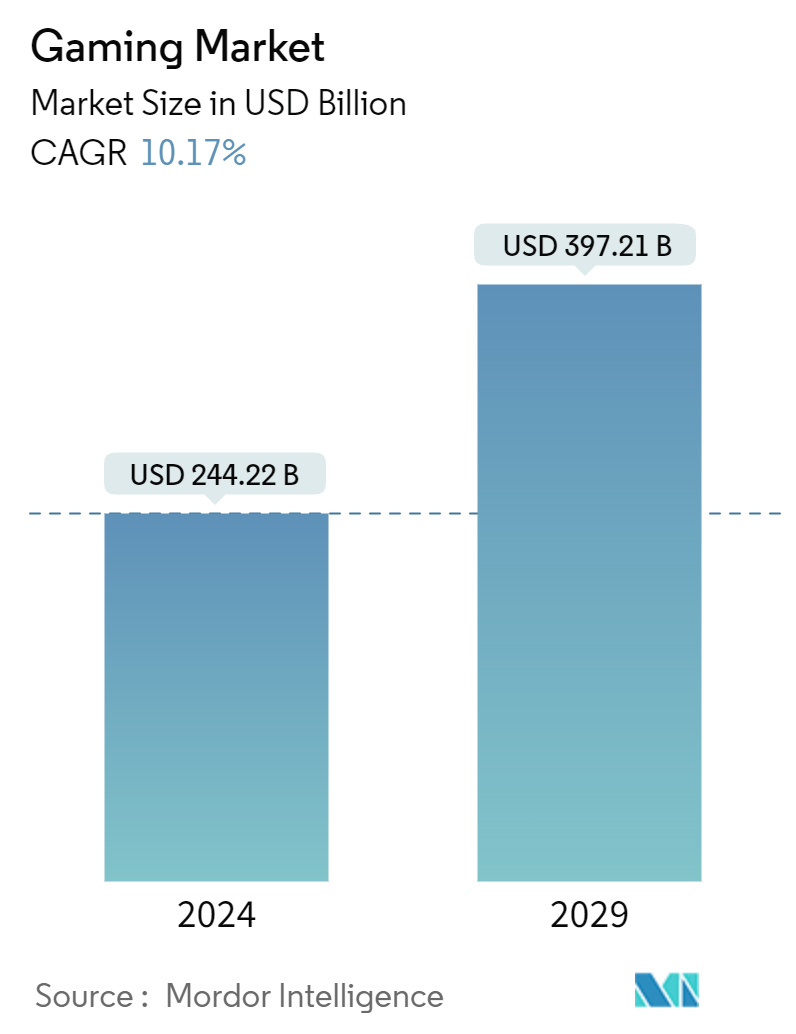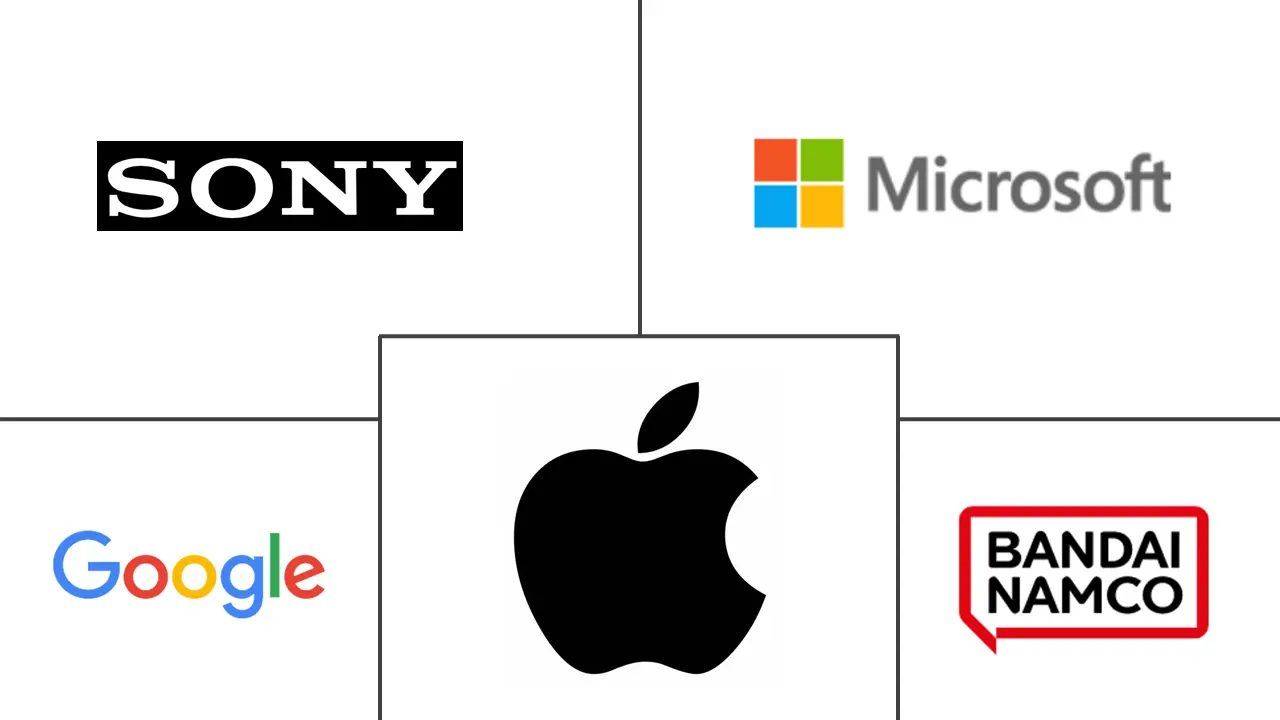Market Size of Gaming Industry

| Study Period | 2019 - 2029 |
| Market Size (2024) | USD 244.22 Billion |
| Market Size (2029) | USD 397.21 Billion |
| CAGR (2024 - 2029) | 10.17 % |
| Fastest Growing Market | Asia Pacific |
| Largest Market | Middle East and Africa |
Major Players
*Disclaimer: Major Players sorted in no particular order |
Gaming Industry Analysis
The Gaming Market size is estimated at USD 244.22 billion in 2024, and is expected to reach USD 397.21 billion by 2029, growing at a CAGR of 10.17% during the forecast period (2024-2029).
- The global gaming industry is experiencing increased demand due to rising internet connectivity, growing smartphone adoption, and the introduction of high-bandwidth networks like 5G. In addition, several operators have launched commercial 5G services with significant population penetration, opening new opportunities for mobile vendors to introduce 5G smartphones in the market.
- The continuous technological advancements in the gaming industry are also significantly propelling the industry's growth. They enhance the way games are created and improve users' overall gaming experience. Game developers in emerging economies continually strive to enhance the gaming experience. They achieve this by developing and optimizing codes for various platforms, including PlayStation, Xbox, and Windows PC. These efforts result in a unified product delivered to gamers via cloud platforms.
- According to NewGenApps, by 2025, the global user base of AR and VR games is estimated to increase to 216 million. According to a worldwide survey of technology company executives, startup founders, and investors, 59% of the respondents believe gaming will dominate the investment in developing VR (Virtual Reality) technology. In addition, as cryptocurrency continues to be a global phenomenon, various industries across the world are identifying ways to incorporate crypto into their products and services as game developers are inventing new methods to leverage cryptos for purchasing and trading in-game products, cosmetics, and unlocked characters.
- The gaming market share is significantly driven by the rising adoption of gaming platforms like E-sports. E-sports are witnessing a significant increase in market share in the current market scenario, thereby driving the overall gaming industry across the world. The entire e-sports market is anticipated to grow over the coming years. Most of the audience and players of E-sports are millennials. Thus, esports publishers target these customers by personalizing the gameplay experience and offering the game on different platforms through the console, PC, and mobile.
- The gaming industry is witnessing a surge in Non-Fungible Tokens (NFTs) and a growing adoption of the play-to-earn (P2E) model. These trends are reshaping game development, gameplay, and revenue streams, providing players and developers with fresh opportunities for interaction and income.
- According to gaming industry trends, the market is witnessing rising fraud cases, such as copyright infringement and fake gaming sites, among others. Emerging and evolving fraud trends are increasing account takeover attacks across industries, especially online gaming. Game hacking is further increasing, resulting in fraud related to customer accounts and personal identity thefts.
Gaming Industry Segmentation
The gaming industry is defined based on the revenues generated from the gaming types used across the world. The analysis is based on the market insights captured through primary and secondary. The market also covers the major factors impacting gaming industry growth in terms of drivers and restraints.
The gaming market is segmented by gaming type (mobile games, console games, downloaded/box PC, and e-sports) and key geographies (North America [United States and Canada], Europe [Germany, the United Kingdom, France, Russia, Spain, Italy, and the Rest of Europe], Asia-Pacific [China, Japan, South Korea, India, Taiwan, Indonesia, Australia, and the Rest of Asia-Pacific], Latin America [Brazil, Argentina, Mexico, and the Rest of Latin America], and the Middle East and Africa [the United Arab Emirates, Saudi Arabia, Iran, Egypt, Turkey, Israel, and the Rest of the Middle East and Africa]). The gaming market share, spending and forecasts are provided in terms of value (USD), in addition to gamer demographics such as gender, gamer population, and genre.
| By Gaming Type | |
| Mobile Games | |
| Console Games | |
| Downloaded/Box PC | |
| E-sports |
| By Geography*** | ||||||||
| ||||||||
| ||||||||
| ||||||||
| Australia and New Zealand | ||||||||
| ||||||||
|
Gaming Market Size Summary
The gaming industry is experiencing robust growth, driven by factors such as increased internet connectivity, widespread smartphone adoption, and the rollout of high-bandwidth networks like 5G. These advancements are creating new opportunities for mobile vendors and enhancing the gaming experience through technological innovations. Game developers, particularly in emerging economies, are focusing on optimizing codes for various platforms, including PlayStation, Xbox, and Windows PC, to deliver a unified product via cloud platforms. The industry's expansion is further fueled by the rising popularity of E-sports, the integration of Non-Fungible Tokens (NFTs), and the adoption of the play-to-earn model, which are reshaping game development and revenue streams. However, the industry also faces challenges such as increasing fraud cases, including copyright infringement and account takeover attacks.
The market is highly consolidated, with major companies like Sony, Microsoft, Nintendo, and Tencent Holdings Limited leading the charge. These companies are investing heavily in research and development to enhance gaming technology, offering high-quality graphics and faster speeds. The demand for gaming consoles is on the rise, supported by the diversification of games and the convenience of digital downloads. The Asia-Pacific region, with its diverse economies and growing gamer base, presents significant opportunities for gaming companies. Technological innovations and the popularity of mobile gaming are particularly driving growth in Japan, where social gaming is fostering community among players. Global gaming companies are strategically entering new markets through partnerships and acquisitions, further expanding their reach and influence.
Gaming Market Size - Table of Contents
-
1. MARKET INSIGHTS
-
1.1 Market Overview
-
1.2 Industry Attractiveness - Porter's Five Forces Analysis
-
1.2.1 Bargaining Power of Suppliers
-
1.2.2 Bargaining Power of Buyers
-
1.2.3 Threat of New Entrants
-
1.2.4 Threat of Substitute Products
-
1.2.5 Intensity of Competitive Rivalry
-
-
1.3 Technology Snapshot
-
1.4 Assessment of the Impact of COVID-19 on the Market
-
-
2. MARKET SEGMENTATION
-
2.1 By Gaming Type
-
2.1.1 Mobile Games
-
2.1.2 Console Games
-
2.1.3 Downloaded/Box PC
-
2.1.4 E-sports
-
-
2.2 By Geography***
-
2.2.1 North America
-
2.2.1.1 United States
-
2.2.1.2 Canada
-
-
2.2.2 Europe
-
2.2.2.1 Germany
-
2.2.2.2 United Kingdom
-
2.2.2.3 France
-
2.2.2.4 Russia
-
2.2.2.5 Spain
-
2.2.2.6 Italy
-
-
2.2.3 Asia
-
2.2.3.1 China
-
2.2.3.2 Japan
-
2.2.3.3 South Korea
-
-
2.2.4 Australia and New Zealand
-
2.2.5 Latin America
-
2.2.5.1 Brazil
-
2.2.5.2 Argentina
-
2.2.5.3 Mexico
-
-
2.2.6 Middle East and Africa
-
2.2.6.1 United Arab Emirates
-
2.2.6.2 Saudi Arabia
-
2.2.6.3 Iran
-
2.2.6.4 Egypt
-
-
-
Gaming Market Size FAQs
How big is the Gaming Market?
The Gaming Market size is expected to reach USD 244.22 billion in 2024 and grow at a CAGR of 10.17% to reach USD 397.21 billion by 2029.
What is the current Gaming Market size?
In 2024, the Gaming Market size is expected to reach USD 244.22 billion.

